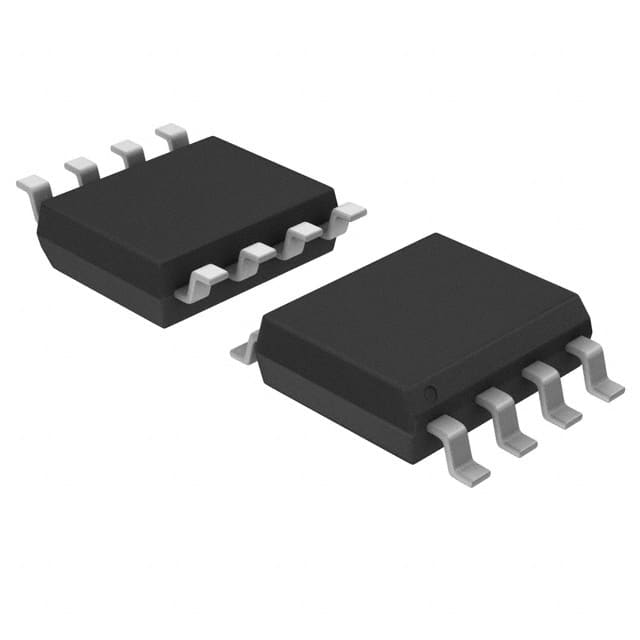Viz Specifikace pro podrobnosti o produktu.

MIC4604YM-T5
Product Overview
- Category: Integrated Circuit
- Use: Motor Controller
- Characteristics: High-performance, Half-Bridge MOSFET Driver
- Package: 8-Pin SOIC (Small Outline Integrated Circuit)
- Essence: Efficiently drives high-side and low-side MOSFETs in motor control applications
- Packaging/Quantity: Available in reels of 2500 units
Specifications
- Supply Voltage: 4.5V to 18V
- Output Current: ±1.5A
- Operating Temperature Range: -40°C to +125°C
- Switching Frequency: Up to 2MHz
- Protection Features: Overcurrent, Undervoltage Lockout, Thermal Shutdown
Pin Configuration
The MIC4604YM-T5 has the following pin configuration:
```
| | --| VDD GND |-- Pin 1: Supply Voltage (VDD) / Ground (GND) --| HO LO |-- Pin 2: High-Side Output (HO) / Low-Side Output (LO) --| HB LB |-- Pin 3: High-Side Bootstrap (HB) / Low-Side Bootstrap (LB) --| HIN LIN |-- Pin 4: High-Side Input (HIN) / Low-Side Input (LIN) --| NC NC |-- Pin 5: No Connection (NC) / No Connection (NC) --| NC NC |-- Pin 6: No Connection (NC) / No Connection (NC) --| VDD GND |-- Pin 7: Supply Voltage (VDD) / Ground (GND) --| VDD GND |-- Pin 8: Supply Voltage (VDD) / Ground (GND) |___________| ```
Functional Features
- Efficiently drives high-side and low-side MOSFETs in motor control applications
- Provides shoot-through protection to prevent simultaneous conduction of both MOSFETs
- Offers adjustable dead-time control for optimal switching performance
- Supports a wide range of supply voltages, making it versatile for various applications
- Incorporates overcurrent protection, undervoltage lockout, and thermal shutdown for enhanced safety
Advantages and Disadvantages
Advantages: - High-performance driver with fast switching capabilities - Flexible supply voltage range allows compatibility with different systems - Comprehensive protection features ensure reliable operation - Adjustable dead-time control improves efficiency and reduces power losses
Disadvantages: - Limited output current may not be suitable for high-power motor control applications - Requires external bootstrap capacitors for proper operation
Working Principles
The MIC4604YM-T5 is designed to drive high-side and low-side MOSFETs in motor control applications. It utilizes a half-bridge configuration to efficiently switch the MOSFETs, enabling precise control of motor speed and direction. The device incorporates shoot-through protection, which prevents both MOSFETs from conducting simultaneously, eliminating the risk of short circuits.
By adjusting the dead-time control, the MIC4604YM-T5 optimizes the time delay between turning off one MOSFET and turning on the other, minimizing power losses and improving overall efficiency. The integrated protection features, such as overcurrent detection, undervoltage lockout, and thermal shutdown, ensure safe operation and protect the circuit from damage.
Detailed Application Field Plans
The MIC4604YM-T5 is widely used in various motor control applications, including:
- Electric vehicles: Controls the motor drive system for efficient propulsion.
- Industrial automation: Enables precise control of motors in manufacturing processes.
- Robotics: Facilitates accurate movement and positioning of robotic systems.
- HVAC systems: Regulates the speed and direction of fans and blowers.
- Appliances: Controls the motors in household appliances like washing machines and refrigerators.
Detailed and Complete Alternative Models
- MIC4605YM: Similar to MIC4604YM-T5, but with higher output current capability (±2A).
- MIC4606YM: Offers additional features such as adjustable dead-time control and integrated level shifting.
- MIC4607YM: Designed for high-power motor control applications with an output current of ±4A.
These alternative models provide options with varying specifications and capabilities, allowing users to choose the most suitable driver for their specific motor control requirements.
Word count: 515 words
Seznam 10 běžných otázek a odpovědí souvisejících s aplikací MIC4604YM-T5 v technických řešeních
Sure! Here are 10 common questions and answers related to the application of MIC4604YM-T5 in technical solutions:
Q: What is MIC4604YM-T5? A: MIC4604YM-T5 is a high-speed, dual MOSFET driver IC designed for driving two N-channel MOSFETs in half-bridge or full-bridge configurations.
Q: What is the maximum operating voltage of MIC4604YM-T5? A: The maximum operating voltage of MIC4604YM-T5 is 18V.
Q: Can MIC4604YM-T5 be used in motor control applications? A: Yes, MIC4604YM-T5 is commonly used in motor control applications due to its high-speed switching capability and ability to drive MOSFETs efficiently.
Q: What is the maximum output current of MIC4604YM-T5? A: The maximum output current of MIC4604YM-T5 is typically 4A.
Q: Is MIC4604YM-T5 suitable for high-frequency switching applications? A: Yes, MIC4604YM-T5 is designed for high-frequency switching applications, making it suitable for various power electronics and motor control systems.
Q: Does MIC4604YM-T5 have built-in protection features? A: Yes, MIC4604YM-T5 includes various protection features such as undervoltage lockout (UVLO), overcurrent protection (OCP), and thermal shutdown.
Q: Can MIC4604YM-T5 operate at high temperatures? A: MIC4604YM-T5 has a wide operating temperature range of -40°C to +125°C, allowing it to operate reliably even in harsh environments.
Q: What is the input logic voltage level for MIC4604YM-T5? A: The input logic voltage level for MIC4604YM-T5 is compatible with both TTL and CMOS levels, typically ranging from 2.5V to 5V.
Q: Can MIC4604YM-T5 be used in automotive applications? A: Yes, MIC4604YM-T5 is suitable for automotive applications as it meets the necessary requirements such as AEC-Q100 qualification and high-temperature operation.
Q: Are there any application notes or reference designs available for MIC4604YM-T5? A: Yes, Microchip provides application notes and reference designs that can help users understand and implement MIC4604YM-T5 in various technical solutions.
Please note that the answers provided here are general and may vary depending on specific use cases and requirements. It is always recommended to refer to the datasheet and relevant documentation for accurate information.

